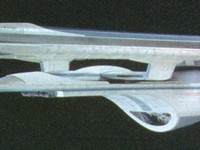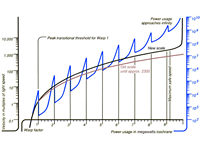Faster Than Warp
History and Future of Transwarp Propulsion Research & Development in the Federation
A report by Bernd Schneider
First Steps
Zefram Cochrane conceived the first theory about a deeper subspace domain, nowadays informally known as "transwarp", as soon as in the 2070's. He postulated that subspace were composed of different layers, each layer having the same properties relative to the layer above as has the uppermost subspace level (i.e. the known subspace) to normal space. One impact of his theory was that even with conventional warp drive a part of the warp field would always extend into deeper subspace domains, and this could be indirectly determined by a slight deviation of the warp drive power expenditure from the predicted value at a certain warp factor. Unfortunately the sensor equipment to measure subspace field stress was not precise enough and, moreover, speeds at which the effect would show up significantly could not be reached at that time. This is why Cochrane's theory remained a theoretical possibility for almost a century, and was not supported by most contemporary scientists. Nevertheless the aging warp flight pioneer spent more than two decades refining his theory. He initiated the Warp 5 development in an effort to acquire further knowledge about deeper subspace. In order to focus on theoretical work again, he handed over the lead to Henry Archer soon after the opening of the Warp Five Complex and settled on Alpha Centauri. From there, he eventually disappeared in 2121, leaving no traces of his latest work.
Cochrane's theory was eventually proven in 2164, when scientists on the Daedalus-class starship USS Frontier NCC-175 reported a power difference of -0.075% at Warp 4.2 compared to the expected expenditure, owing to a minute amount of power flowing to the lower subspace level, where it resulted in a further mass reduction as well as a propulsive effect. This discovery was the incentive for an extensive research program with the goal to make deliberate use of this power saving effect. Subspace physicists and starship engineers were aware of the fact that the power required to achieve and sustain high warp speeds well beyond Warp 7 would be beyond the capabilities of conventional warp coils and warp cores. In order to further promote the project, the name "Transwarp (I)" was conceived for the supposed uppermost of the lower subspace domains, while the subsequent deeper levels were tentatively named "Transwarp II" and so on.
A technical solution to take advantage of the transwarp domain was not discovered until the year 2221, when the Yoyodyne Corporation presented their Mark II transwarp coil. At that time, however, no suited starship was available as a testbed. Moreover, Starfleet was skeptical about the new technology, since the device, despite the obvious energy savings at high speeds, required more power input at lower speeds and during acceleration. At first the Mark II coil was therefore tested on Yoyodyne's own Lunar Test Area, creating a static, non-propulsive warp field. It took another five years until finally a ship was fitted with the new propulsion system, the USS Ripley NCC-1495. The experiment utterly failed, when the warp core overloaded just after reaching Warp 1. Luckily the ejection system worked, and the ship and crew were not harmed. Further experiments with a new warp core could not convince Starfleet Command, and starship design focused on the development of new high-performance conventional warp drives, as in the Constitution class, for instance.
The Excelsior Project
In the 2260's, however, it became clear that conventional warp drive had finally arrived at its upper performance limit. Constitution-class starships were able to achieve a cruising speed of Warp 6, and the planned upgrade of this class would not be likely to further increase the ship's speed. Higher velocities were possible, but the energy expenditure and the stress to the system components was enormous. Moreover, the creation of multiple warp field layers (each of them corresponding to one warp factor) was difficult, because not only the speed, but also the adjustment and control efforts would rise roughly with the third power of the layer count. On the other hand, transwarp was efficient only in the range above Warp 6. The solution was to combine the concepts in that each nacelle was fitted with both conventional and Yoyodyne's to be developed Mark IV transwarp coils in an alternating arrangement. This is the basic concept of the Transwarp Development Project, on which work officially began at San Francisco Fleet Yards in 2267.
While Starfleet Command was quick to assign the hull number NX-2000 to the new ship, its name was in dispute at first. Scientists and fleet yards personnel voted for "USS Cochrane" to honor the warp flight pioneer. Starfleet Command, however, objected that a ship with this name was already in service (and not supposed to be retired soon) and large ships usually would not be named after scientists. It was an employee at Starfleet Headquarters in San Francisco who, without authorization by his superiors, suddenly started naming the new ship "Excelsior" in official communications, and eventually all sides agreed to this name.
Apart from the novel propulsion principle the Excelsior was supposed to be 50% longer and to have more than twice the internal volume of a Constitution class ship. The basic hull design was finished in 2269. Subsequently the main systems of the ship, including impulse engines, computer core, SIF, IDF, sensors and weapons were simulated and designed. The Excelsior was to be fitted with special scientific equipment for measuring quantities like the power system efficiency and warp field strength, with an option to install standard equipment in a possible series version. The development of the energy and propulsion systems imposed a delay on the project several times. These components required no less than eight design and review cycles of which four had not been originally scheduled. Finally, in 2274, the design was frozen and ready to undergo a complete simulation of all systems. At that time a second engineering crew had already started to plan the construction process and prepare the construction facility.

One main prototype ship, the USS Excelsior NCC-2000, was built in advance. The first components were assembled at the fleet yards in 2275. Another two ships, the USS Capitol NCC-2116 and the USS Tirpitz NCC-2117 were being built with fourteen months delay to the Excelsior. These ships were supposed to test the efficiency of the construction process and, after their completion, to serve as backup ships and gather reference data. The spaceframe of the Excelsior was completed by 2277, together with one of the computer cores, the main deflector and part of the habitat modules. The warp nacelles and Mark IV transwarp coils were assembled at Yoyodyne's Earth orbit facility, along with most part of the warp power generation and distribution system, and transferred to San Francisco Fleet Yards in 2278. In the following two years, these components along with the impulse and weapon systems were installed and the first hull plates were attached. The power systems were first tested in 2279, still, at only 2% of their nominal output. With the shuttlebays, transporters, main sensor systems, SIF and IDF finished, the so-called "non-essential" components were installed from 2280, including the rest of the hull plates, most of the habitat modules, secondary power conduits, computer sub-systems and turbolifts. Although 20% of the internal modules were still missing, the construction of the Excelsior was officially declared finished in 2282 and the ship was launched from the construction facility.
Captain Styles was assigned command of the ship during its test phase. The ship was scheduled for complete hardware tests, including full impulse flights and newly developed shakedown tests, while work on controlling the hybrid warp/transwarp propulsion system was still underway. Actually, the ship spent more time in Earth Spacedock than in space during that period. In 2284, Captain Styles announced that the ship was now ready for the first warp flight, and the head of the construction project approved of it. Captain Montgomery Scott was assigned chief engineer of the ship. Although Scott had not been directly involved in the construction process, Starfleet Command expected that the expertise of a skilled starship engineer would help to find solutions the construction team had not thought of. Admiral Kirk's hijacking of the USS Enterprise NCC-1701 required the first warp flight of the Excelsior to take place earlier than scheduled. Scott, however, reluctant to fit into his new position and eager to help his comrades, sabotaged the warp drive, so that the Excelsior could not reach warp, let alone transwarp speed.
Four days later the problem had been fixed, and the Excelsior achieved Warp 6 outside the solar system, thereby proving she was spaceworthy. Transwarp was first tested two months later, and the speed was increased up to an equivalent of Warp 9 in the subsequent flights. The energy saving compared to normal warp drive was 30%. So far the transwarp drive was a success. After only six months in service, however, the efficiency of the transwarp coils had dropped by more than 10%. Further investigation yielded the explanation that the deep subspace field led to an accumulation of verteron particles inside the verterium cortenide warp field coil. An excessive verteron flow had been predicted, however, the effect of the inherent material impurity had been underestimated. This enabled a chain reaction: verteron particles get trapped in the material impurities, and their presence attracts even more particles, leading to discontinuities in the crystalline structure and finally to microfractures. In the following two years, while material scientists tried to improve the warp coil manufacturing process and thereby the material quality, warp system engineers worked on a procedure to purge the warp coils. It turned out that once a warp coil was affected, it was not possible to completely recover its original efficiency, and even a stationary maintenance could only repair up to 50% of the damage. This is the ultimate reason why Starfleet decided to give up the Excelsior project in 2287.
The USS Capitol and USS Tirpitz had never been completed because of the problems with the Excelsior, and these two ships were first retrofitted to normal warp drive by swapping the transwarp coils with conventional ones and by several changes to the power system. Moreover, the shuttlebay maintenance area was rebuilt and a smaller bridge module was installed that better served the every-day use of the ship. The Excelsior followed in 2289, although warp field scientists had demanded that at least this ship should be preserved as a testbed for new, improved transwarp coils. The ship was re-commissioned in 2290, now with the registry NCC-2000, and began a two-year exploration mission in the Beta Quadrant under the command of Captain Hikaru Sulu in 2291. Sulu stayed in command for another ten years, until he retired. The Excelsior was refitted in 2311, 2335 and 2359 so as to fulfill Starfleet technical standards. The ship is still in the service as of 2375, with the seventh Captain in command. As part of Starfleet's Ninth Fleet the ship took damage in several major battles, and it is scheduled to be decommissioned and displayed in the Starfleet Museum.
24th Century Developments
The Excelsior Project had lasting effects in spite of its failure. It led to a refinement of the warp scale that had assumed an exact third-power relation between the warp speed and the subspace field stress (the Warp factor) for two centuries. The effect on the scale was two-fold. Firstly, the power saving could be accounted for. It was already known that the fraction of subspace field power extending into deeper layers would increase the practically achieved speed above the third-power law at Warp factors in excess of about Warp 5. But the exact physics behind this effect could be confirmed as late as the measurement data from the Excelsior became available. The refinement was incorporated into the speed calculation in the form of an additive correction term.

Secondly, a practical limit of nine warp field layers was found, beyond which the efficiency of conventional warp drive, as it was installed on the Excelsior too, would drop below 23% (the already known efficiencies ranging from 97% at Warp 1 to 64% at Warp 8). It should be noted that Federation starships, under unusual conditions, had previously been reported to achieve speeds in excess of Warp 8, even up to Warp 14. These speeds, however, did not necessarily comply with an actual number of warp field layers, but have to be regarded as mere equivalent speeds. The Excelsior herself was the first Federation ship to use nine nested layers with a regular engine, therefore being capable of achieving true conventional Warp 9. All attempts to boost this to ten layers on the Excelsior and on later vessels failed, as the engine power was never sufficient to cross the peak transitional threshold at Warp 10. Letting the scale end at Warp 10 seemed somewhat arbitrary, though. Anyways, it reflected the decision not to rely on any more than nine warp field layers. Any speed beyond Warp 9 would have to be achieved still using nine layers. Whilst working with this new scale was still convenient in the late 23rd century with usual top speeds of Warp 8, it imposed practical problems beginning in the early 2370's. Now several digits like "Warp 9.975" have become necessary to express speed differences well beyond the Warp 9 threshold precisely enough. While the scale correctly reproduces the physical side of using no more than nine nested layers, ordering the helm to go to high warp has become complicated.
There is another salubrious effect of the Excelsior Transwarp Project. The experience gathered with the warp coil purging proved useful when Starfleet asked for decontamination procedures for the ship. The now familiar so-called "baryon sweep" to remove accumulative impurities in the whole starship hull and spaceframe has its roots in the unsuccessful attempts to improve the crystalline structure of verterium cortenide warp coils, although the effect of the new procedure on the warp drive efficiency alone is only marginal.
Transwarp Now?
Starfleet has lately been in contact with several civilizations using advanced FTL propulsion. All these different technologies are casually designated "transwarp", although they all have little in common with the Excelsior Project. Actually, "Transwarp" has become a collective name for any technology suitable to overcome the limitations of conventional warp.
Two fundamental principles of transwarp may be distinguished. The first is shipboard drive as it is used by the Voth in the Delta Quadrant. The data gathered on this principle by USS Voyager is scarce. It appears that Voth transwarp is indeed based on exploiting the lower subspace domains. But most likely, this technology does not envelop the ship which always remains in normal space, into a "warp bubble", like all warp drives of the Federation so far including Excelsior transwarp. Rather than that, the whole ship is pushed into subspace, comparable to subspace radio signals. Creating a field gradient strong enough to accomplish this is currently beyond the potential of Federation technology. It has been suggested, however, that this might be possible once the Warp 10 peak transitional threshold could be broken (Warp 10 referring to the pre-Excelsior scale!), which may act as a final barrier to the Transwarp I domain. Experiments performed in this field in the late 2360's turned out quite promising. A yet unconfirmed report from USS Voyager states that a shuttle with remodulated warp drive indeed managed to create ten nested layers and ultimately entered Transwarp I. This report, however, was rated not trustworthy by the Federation Science Council, although extensive sensor data including medical logs on the flight's effects on the passenger still remain to be verified. (There were premature rumors that the shuttle may even have reached Warp 10 in the meaning of "infinite speed", but this amateurish claim was quickly discarded by Federation scientists and was occasionally cited as a practical joke to cheer up boring presentations on scientific conferences.)
The other basic type of transwarp drive is the one that opens subspace ahead of a vessel, creating wormhole-like channels through which even more than one vessel could travel at a time. In order to avoid confusion, it has to be annotated that a conventional wormhole (like the Barzan Wormhole and fundamentally the artificial Bajoran Wormhole too) is actually a space inversion and not chiefly a subspace phenomenon, although many of its side effects become apparent in subspace too. Some transwarp channels, namely the transwarp network of the Borg and the corridors used by the Vaadwaur, are even reported to be permanent. Other sub-types of transwarp channels, including the technology now familiar as "quantum slipstream", resemble an elongated bubble which moves the ship through subspace and which may be controlled during the flight to a certain extent. Borg transwarp and slipstream drive require only minor modifications to the very propulsion systems of the ship. This is why they have already been successfully tested on Voyager in the years 2374 and 2375. Rather than continuous shipboard transwarp drive, Borg transwarp and slipstream drive are candidates to become the future propulsion technology of Starfleet. R&D activities on these topics are currently extensively funded. Warp field physicists and engineers, however, warn of a premature enthusiasm. They estimate that another ten years of fundamental research will be necessary until the basics of these technologies are fully understood and may be produced in series and safely integrated into Federation starships.
In the wake of the newly discovered technology, it has been suggested to modify the warp scale once again within the next decade, in order to take into account transwarp factors or, more precisely, layers of deeper subspace (Transwarp I, II etc.) that may be reached using transwarp drive. It remains to be seen whether this new scale will refer to the first transwarp level as "Transwarp I", or whether it will (again) include Warp 10, 11 etc. as a more familiar equivalent to "Transwarp I, II" etc.



